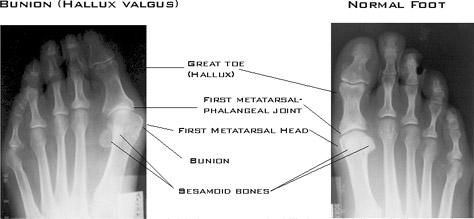
| FOOT DISORDERS - Bunion |
The bunion, or hallux valgus, is a condition that
affects the bones and joints associated with the great toe. It is one of the
most common deformities of the forefoot. The condition develops slowly and
results from the gradual dislocation of the joint, usually because of
instability during gait. There is a displacement of the first metatarsal bone
toward the mid-line of the body, and a simultaneous displacement of the great
toe away from the mid-line (and toward the smaller toes). This causes a
prominence of bone on the inside (medial) margin of the forefoot, this is termed
a bunion. As the deformity progresses, the big toe will shift toward the outside
of the foot. In severe cases, the big toe will actually overlap or under lap the
second toe. It is often of a hereditary nature, but it is also associated with
rheumatoid arthritis and other diseases. There are no exercises, splints or
other devices that reliably correct a bunion. Orthotics can sometimes slow or
halt the progression by addressing the instability which causes the deformity,
but they cannot reduce the deformity.
Painful bunions decrease one’s ability to perform desired activities, and makes
shoe fitting difficult. Surgery may be performed to correct the deformity.
Though a bunion is often described as a painful bump, this condition is much
more complex than a simple bump on the side of the toe. X-rays show the true
nature of the deformity and are used to help in the decision making process.
Ranges of motion of joints associated with the toe are also performed to assess
the deformity. There are many procedures for correcting a bunion and choosing
the right one based on the examination increases the chance of success. The
procedure performed on one person may not be the procedure required to give
another a good result. In general, more severe bunion deformities require more
extensive surgery and more extensive post-operative limitations. It is very
important to note that the same instability and incorrect motion that causes a
bunion also causes degeneration of the joint surfaces (osteoarthritis).
Correction of the bunion cannot repair the damage done within the joint and
continued pain from that separate process may occur. Realigning the joint may
slow the damage within the joint and improve motion, but it may not alleviate
all pain.
Complications of bunion surgery are not common, but include infection of soft
tissue and/or bone, slow healing of skin or bone, irritation from fixation pins
or screws, nerve entrapment, reaction to the foreign material (suture material,
pins or screws), excessive swelling, excessive scarring, excessive stiffness
(some stiffness is unavoidable), over-correction (hallux varus) and recurrence
of the deformity. Rarely, some complications may require a second surgery to
correct the problem. While these complications are rare, they should be weighed
against the difficulty that you are experiencing to determine whether surgery is
an acceptable risk for your condition. This is an important part of the process.
Overview of the bone anatomy of a bunion :

Symptoms
Causes
What you can do
What the doctor may do
Other causes of pain at the great toe joint